Традиции Рождества в жизни современной молодежи, 11 класс
Муниципальное общеобразовательное учреждение
«Маардуская гимназия»
Маарду – Таллинн, Эстония
Научно-практическая конференция школьников «Исследовательская работа школьников»
Исследовательская работа
ученика 12 класса
Дроздова Александра
«Традиции рождества в жизни современной молодежи»
Руководитель:
Наст Галина Петровна
Учитель английского языка,
Старший учитель
Маардуская гимназия
Г. Таллинн
Эстония
Маарду 2011
Scientific-practical conference of students "Student Research"
Research work
Christmas traditions in life of modern youth
Aleksandr Drozdov, 12th grade
Maardu Gymnasium
Scientific Adviser:
Galina Nast,
Senior teacher
Мaardu Gymnasium
Maardu
Estonia
MAARDU 2011.
CONTENTS
CONTENTS……………………………………………………………………………….2
LIST OF PICTURES........................................................................................................
INTRODUCTION…………………………………………………………………………
1. ORIGIN OF THE CHRISTMAS HOLIDAY………………………………………….
1.1 Etymology of word Christmas ...................................................................................
1.2 Analogues of word Christmas in other languages.............................................................
1.3The History of Christmas....................................................................................................
1.3.1 A Virgin Mary and Joseph………………………………………………………..
1.3.2. Christ’s birth..............................................................................................
1.3.3. Ancient Rome…………………………………………………………………. 2. THE MAIN SYMBOLS OF CHRISTMAS..........................................................................
2.1 Christmas tree..................................................................................................
2.2 Folk heroes…………………………………………………………………
2.2.1. Santa-Claus ……………………………………………………………………..
2.2.2Rudolph the Red-Nosed Reindeer............................................................................
3.MODERN TRADITIONS OF CHRISTMAS CELEBRATION…………………
3.1 A Christmas miscellany…………………………………………….
3.2 The Nativity…………………………………………………………
3.3 Gift Receipt…………………………………………………………..
3.4 Rose Parade……………………………………………………………
3.5 The Christmas Pantomime…………………………………………….
3.6 Yule Log………………………………………………………………
3.7 Modern traditions of Christmas celebration………………..
3.7.1 Youth traditions of celebration Christmas…………….
CONCLUSION…………………………………………………………………………….
LIST OF SOURCES…………….............................................................................................
LIST OF PICTURES:
Picture 1.Christ’s birth.
Picture2. Christmas tree at Trafalgar Square in London.
Picture 3. Santa-Claus.
Picture 4. Rudolf the Red-Nosed Reindeer.
Picture 5. Christmas card.
Picture 6. Wise Men Balthasar, Melchior and Caspar present gifts to Christ.
Picture 7. Rose Parade in Pasadena.
Picture 8. The old poster of Christmas Pantomime.
Picture 9. Burning of Yule Log.
INTRODUCTION
Christmas is one of the most popular holidays. It’s celebrated in many countries around the world. In many religions holiday recognized by the church.
Subject of research work is devoted to the traditions of Christmas in the life of modern youth. The choice of this theme has been carried out by taking into account the huge popularity in English-speaking world of a holiday which originally had a religious orientation, and so vivid memorable traditions, which came into Christianity from pagan times, have evolved and made it safely to our century. Interest in this subject was aroused by the fact that the history of the holiday and its traditions associated with the unforgettable and fascinating myths and legends, which are also fertile ground for research.
Subject of research in this work – Christmas holiday. The object of research – attitude of young people to the traditions of the holiday.
Objective: To explore the traditions of Christmas in the life of modern youth.
Research objectives:
1. Consider the origins of Christmas.
2. Examine the principal symbols of Christmas.
3. Explore the contemporary traditions of celebrating Christmas.
To solve these problems we used the following methods:
1. Study and analysis of the theoretical literature.
2. Compare and contrast the studied data of the subject.
3. Description, allowing to establish not only the facts but the relationship between them: a sequence, simultaneity, causality, the relationship of the Christmas traditions.
Chronological framework of the defined objectives: to study modern traditions of Christmas, so to compare with historical analogues, giving characteristics. Therefore, the beginning of the study relates to the origins of the holiday and ends with the modern tradition of celebration.
Geographically, the study deals mainly with the traditions of Christmas celebrations in England, but as the holiday multiethnic, the study will deal with the traditions of Christmas celebrations in Europe.
Hypothesis: Christmas - a religious holiday.
The work consists of an introduction, three chapters, conclusion and list of sources used. The first chapter is devoted to the origin of Christmas. In the second chapter deals with the main symbols of Christmas. The third chapter describes the modern traditions of Christmas celebrations.
1. ORIGIN OF THE CHRISYMAS HOLIDAY.
1.1. Etymology of word Christmas.
Christmas takes its name from the old English Christes, or Christ Mass [1]. The title, “Christ” is form of the Greek word “Christos” which means “Messiah” [2]. The word “Messiah” according to The ALL Nations English Dictionary means “the anointed one’’. ”Jesus Christ was anointed by God with the Holy Spirit and with power to preach good news (the Gospel to the poor,’’. From this dictionary we can also find out that “Jesus Christ is the true Messiah that is the promised Savior of the world. The phrase “Christes Maesse” or “Christmas” was first recorded in 1038.
1.2. Analogues of word Christmas in other languages.
Dutch has a similar word, Kerstmis, often shortened to Kerst. The German name Weinachten means simply “hallowed night”. After the conversion of Anglo-Saxon Britain in the early 7th century, Christmas was referred to as geol, name of the pre- Christian solstice festival from which current English word “Yule” is derived .In early Greek versions of the new Testament, the letter X (chi), is the first letter of Christ. Since the mid-sixteenth century X, or the similar Roman letter X, was used as an abbreviation for Christ [3].
1.3. History of Christmas.
1.3.1. A Virgin Mary and Joseph.
Not far from Jerusalem is Bethlehem. The mother of Jesus - Virgin Mary was born there. Since she was three years old, she was raised in church and in the fourteen years she vowed not to marry and serve only to God. Priests entrusted Mary to Joseph, widower, eighty years old man who replaced her father. They lived in the house of Joseph in Nazareth. Once in the house where lived the Virgin Mary and Joseph, the angel Gabriel appeared and said: "You shal bear a son and name him Jesus. He will be great and shall be called the Son of God, and the Lord God will give him the throne . " [12]
1.3.2. Christ’s birth.
At that time Roman emperor Augustus ordered to carry out census of all the land of Judah. Every Jew had to record where he was born. Therefore, Joseph and Mary went from Nazareth to Bethlehem. It was a difficult road, as Mary was to give birthsoon. In Bethlehem they came late at night, but could not stay because of the large crowds of people either in hotels or in homes of residents, so they stayed in a cave near the town.In this cave, the shepherds in inclement weather drove the cattle. That night the VirginMary had a son. Baby swaddled and laid on straw in a manger, to put livestock feed.(Pic.1) on the eighth day after birth, Joseph and Mary gave him the name Jesus means "God saves"or "savior. "[12]
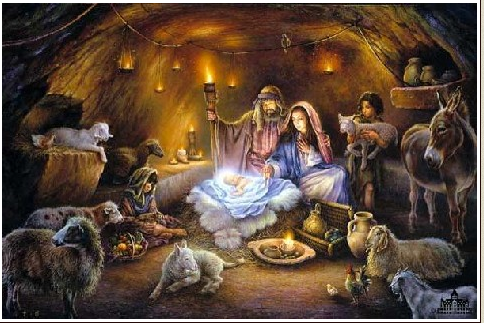
Рисунок 1. Рождение Иисуса.
Рисунок 1. Birth of Jesus
Many people look on Christmas as the time to celebrate the birth of Christ. It has its own history. In fact the early followers of Christ believed that infants entered this world with the original sin of Adam condemning their souls. The world was considered to be a harsh, cruel place. There was no reason to celebrate one’s birth. The death day was the passage to eternal paradise and it was a more significant event. That’s why with the rise of Christianity, the tradition of celebrating birthdays ceased. But in the fourth century the church began to alter its attitude towards birthday celebrations. In fact no one commenced serious discussions to settle the date of Christ’s birth [5], no one knows the exact date and the year of the birth of Christ. The Bible does not give us any clue, and no record was handed down. Christmas may have been celebrated from as early as 98 AD, but it was only in 350 AD that Julius I declared Christmas to be the 25th of December. According to a Roman almanac, the Christian festival of Christmas was celebrated in Rome by AD 336. In Britain this day was a festival long before the conversion to Christianity. The English historian the Venerable Bede relates that “the ancient peoples of Angle began the year on the 25th of December, and the very night was called in their tongue modranecht, that is “mother’s night” [6]. Besides, there is such a version that the 25th of March was the pagan festival of spring. The church adopted this date as that of Mary’s visit by the angel Gabriel, and added nine months to it to arrive at 25 December [7]. Thus, the choice of the 25th of December was rather controversial. Besides, The Catholic Encyclopedia also asserts that Christmas is especially controversial in the 4th century. First of all, the choice of the 25th of December was connected with various customs, many of which have been influenced by early winter solstice.
1.3.3. Ancient Rome.
The Romans feasted at the Saturnalia; worshipers of the Persian sun god Mithraism celebrated December 25 as the birthday of the invincible sun. The date of Christmas was probably fixed arbitrarily for the same day because it coincided with and offered competition to these pagan Festivities [8]. People were interested as the brightest star the sun attracted even a primate man. In those days the sun meant so much people that when it began to go lower each day till December 23 people worried for they thought the sun was dying out. They watched the sun and ate less keeping the food for the next year. On December 23, the sun stayed longer in the sky and gradually the days became longer and the nights shorter. When this happened the primitive man was very happy. He even felt he wanted to celebrate it. Now he could eat more- he was not afraid for his future any longer. It was wonderful. Gradually man began to understand the material of the sun. December 25 was approximately the date of the solstice. In fact, solstice is the time of the year when the sun is farthest from the equator, June 22 and December 22. In modern times, solstice falls on December 21 or 22 [10]. The birth of the Christ Child is associated with winter solstice because it was meant to bring light into a world of darkness. For Christians this day marked the coming of the sun of God to the Earth in human form. The story of Christmas was based on the biblical accounts given in the Gospel of Matthew and the Gospel of Luke.
In winter solstice was also the most practical time for the feast to be held: cattle which couldn’t be fed through the winter were slaughtered in late autumn, and as a result winter would be the only time when European peasants were most likely to have a stock of fresh meat, which needed to be either salted, or eaten. Equally the beer which had been brewed in autumn would be just ready to drink by the time of winter festivals.
Over the centuries many have tried to revert to a more solemn celebration of Christ’s birth: Oliver Cromwell cancelled Christmas after the events of the English Civil War, disquieted by the behavior of common people at what was supposed to be a religious festival.
To sum up we should assert that church adopted the date of Christmas according to the interests of European peasant.
2.THE MAIN SYMBOLS OF CHRISTMAS.
2.1 Christmas tree. The Christmas Tree is often explained as Christianization of pagan tradition and ritual surrounding the Winter Solstice, which included the use of evergreen plants and adoption of pagan tree worship [1]. The tradition dates back to the Roman Saturnalia. The legend that associates the fir tree with the Christian celebration comes from Germany, and goes back to the 8th century.
The people of Germany believed that the first person to have decorated a Christmas tree was Martin Luther (1483-1546). One day as he was walking through a forest he looked up at the sky which was full of stars. He was touched by the beautiful sight. He took home a small fir tree which he decorated with lighted candles, as a reminder to his followers of the heavens [2].
Nowadays many argue that Martin Luther began the tradition in the 16th century. The modern Christian tree tradition is believed to have begun in Germany in the 18th. The English language phrase “Christmas tree” was first recorded in 1835 and represents an important borrowing from the German language.
From Germany the custom was introduced to England, first by Queen Charlotte, wife of George III, and then more successfully by Prince Albert during the Queen Victoria’ reign..
Prince Albert was born in Germany where the decorated tree was already an established part of the Christmas tradition. In 1840 he introduced a beautiful tree into the royal family’s Christmas, and many other people soon followed him.
*Charles Dickens (1812- 1870), one of the world’s greatest novelists, who lived in the time of starting the tradition of decorating a Christmas tree in Great Britain, confirms German origin of a Christmas Tree. He called a Christmas Tree “that pretty German toy”: “I have been looking on, this evening, at a merry company of children assembled round that pretty German toy, a Christmas Tree. The tree was planted in the middle of a great round table, and towered high above their heads. It was brilliantly lighted by a multitude of little tapers; and everywhere sparkled and glittered with bright objects” [3].
Charles Dickens stresses that the main role of a Christmas tree is creating the atmosphere of happiness: “Now, the tree is decorated with bright merriment, and song, and dance, and cheerfulness. And they are welcome. Innocent and welcome be they ever held, beneath the branches of the Christmas Tree, which cast no gloomy shadow! But, as it sinks into the ground, I hear a whisper going through the leaves.” This, in commemoration of the law of love and kindness, mercy and compassion. This, in remembrance of Me!”
Besides, his words “in remembrance of Me” prove that the tradition of decorating a Christmas Tree became a part of everybody’s life. Nowadays people can’t imagine the holiday without this important symbol. Evergreen or artificial fir trees decorate their houses. Every Christmas British people get a huge fir tree from Norway which stands in Trafalgar Square, in the center of London, shinning down on all the people who gather on Christmas Eve.(Pic.2)

Picture 2. Christmas tree at Trafalgar Square in London
2.2 Folk Heroes
2.2.1. Santa-Claus.
Of all folk heroes, Santa Claus is probably the most familiar and the most misunderstood.(Pic.3) The name is strictly an Americanism. The American Santa Claus is the latest step in a legend that began in the fourth century in Asia Minor. The prototype of the Christmas gift- bringer was the bishop of Myra, St. Nicholas, who was universally loved for his generosity and who today remains a principal saint of the Eastern Church [4].
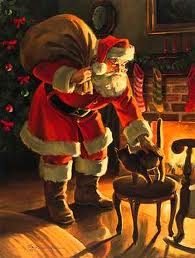
Picture 3. Santa-Claus.
Pressed in a bishop’s garb and sporting a long while beard, he is supposed to have left good children presents on his feast day, December 6. Reformation zealots banished this honey character from the Church calendar, and he was widely replaced by the Christmas Man, a secular Yuletide supplier known in England as Father Christmas. There is also another legend connected with this folk hero. According to it, Saint Nicholas brought a dowry for three girls, who were too poor to find husbands. Whilst they were sleeping he put the gift in their stockings, which were hung by the fire to dry [5].
The cult of Saint Nicholas spread across much of Europe. More surprising, Santa Claus didn’t always arrive at Christmas. In Europe he showed up on December 6.
In Western culture Santa Claus is also known as Father Christmas, Saint Nicholas or St. Nicholas, Kris Krihge, Saint Basil and Father Frost [6].
The idea of St. Nicholas spread about America with the Dutch colonists, and it was the American press, that transformed Father Christmas into his current image. Clement Moore’s poem “The night Before Christmas” published in 1822, introduced Father Christmas flying reindeer, and the way he distributed presents down chimney stacks to the world.
According to another source the popular image of Santa Claus was created by the German-American cartoonist Thomas Nast (1840-1902), who drew a new image annually, beginning in 1863. By the 1880s, Nast’ Santa had evolved into the form we now recognize. The image was standardized by advertisers in 1920.Father Christmas, who predates the Santa Claus character, was first recorded in the 15th century, but was associated with holiday merrymaking and drunkenness [7]. In Victorian Britain, his image was remade to match that of Santa. The French Pere Noel evolved along similar lines, eventually adopting the Santa image. In Italy, Babbo Natale acts as Santa Claus, while La Befana, is the bringer of gifts and arrives on the eve of the Epiphany. It is said that La Befam set out to bring the baby Jesus’ gifts, but got lost along the way. Now, she brings gift to all children [8].
2.2.2 Rudolf the Red-Nosed Reindeer.
Rudolf, the Nosed Reindeer, is considered to be the second popular folk hero Rudolf Christmas. In fact he has two names: Rollo, the Red- Nosed Reindeer and Reginald, the Red- Reindeer.(Pic.4)
The story of Rudolf, the reindeer whose shiny nose lighted Santa Claus’s way “one foggy Christmas Eve”, is as a well- known to American children as the story of Santa himself. Its popularity is the result partly the fact that it is, in sociologist James Barnett’s description, “the only original addition to the folklore of Santa Claus in the century”, and party to the fact that, as a variation on the ugly ducking motif, it addresses children’s innate confusion about social roles. The “lesson” of the Rudolph tale is a necessary and comforting one: Whoever you are, you are special.
The story was created in 1939 by a Montgomery Ward adman named Robert May, known throughout the firm for his light verse. Seeking something that their store Santas could hand out to children, company managers asked May for a poem. With the editorial advice of his four- year- old daughter, he came up with Rudolph and his nose. That first year, 2.4 million copies, illustrated by May’s friend Denver Gilllen, were distributed in Montgomery Ward stores. World War II stopped Rudolph’s rounds, but they picked up again in 1946, and a year later the poem appeared in book form. . In 1949 the red- nosed charmer’s career really took off, when singing cowboy star Gene Autry recorded Johnny Marks’s musical version and propelled it to the top of the Hit Parade. Soon Rudolph was appearing on television and was on hit way to becoming an institution.

Picture 4. Rudolf the Red-Nosed Reindeer.
3. MODERN TRADITIONS OF CHRISTMAS CELEBRTION
3.1 A Christmas miscellany.
The sending of Christmas cards is very much a part of the festival in Great Britain. Something like 650 million were posted here many years ago.(Pic.5)
The cards vary and one can divide them into categories. Out of eighty cards, twenty-one were religious, nineteen had a picture of flowers, holly or pine cones, fourteen were “good cause” cards, nine were views, six had pictures of birds, four had other animals, and seven were “miscellaneous». According to the time-honored tradition, all English children hang a stoking at the foot of their beds on Christmas Eve. During the night Father Christmas comes in his reindeer-drawn sleigh, creeps stealthily down the chimney and fills the stocking with presents But in the twentieth century Father Christmas was moving with the times. For example, when he visited the Pestalozzi international village for refugee children in Sussex, he arrived by helicopter. The children shouted their greetings in a dozen languages as Santa’s “sleigh” made a perfect landing on the village green, and rushed forward to receive their gaily wrapped presents. There was one for each child, and also a splendid Christmas tree for the village library.

Picture 5. Christmas card.
It was Queen Victoria’s consort, Prince Albert, who introduced the Christmas tree to Britain, ever since it has been an essential ingredient of the Christmas season. No family which takes a properly enthusiastic view of the festival could possibly contemplate Christmas without a Christmas tree. It just would not be the same!
With somewhere between ten and twenty million families in Britain, it is not suprising that the seasonal trade in Christmas trees should be brisk. The largest supplier is the Forestry Commission which reckons to sell about half a million trees each year. But there are so many others-large and small landowners, nurserymen, and so on-that it is impossible to estimate the total number sold. Sales of artificial trees. Very attractive they are too, and there is always the advantage that they can be folded up and put away till next year.
There is something else which no English Christmas party could possibly do without-Christmas crackers. Crackers originated in France in the nineteenth century, but in those days they were just a way of wrapping sweets. People took a sheet of colored paper, rolled up the sweets in it and gave it a twist near each end so that they could not fall out. The result was a paper cylinder with two constricted necks. By pulling on each end you tore the paper, and out fell the sweets.
When this simple invitation arrived in Britain someone had the bright idea of putting a minute quantity of gunpowder into each cracker, arranged in such a way that when the cracker was pulled the gunpowder would go pop. The amount is controlled by law, in the interests of safety Nowadays, crackers don’t have sweets in them. They are tiny crackers which are mainly used to hang on the Christmas tree usually contain a plastic charm or similar inexpensive item. Going up in price, you get whistles wire puzzles. [8]
3.2 The Nativity.
The Nativity is a central way in which Christians celebrate Christmas. First of all it helps in expressing a religious significance of the holiday.
Besides it stresses the humble origin of Joseph, the carpenter, and Mary, who must travel to Bethlehem to pay taxes. They go on foot and with a Donkey, and Mary is heavily pregnant. On arrival there is no room in Hostels or inns for them. The only shelter is a manger, a stall of hay and, Straw near oxen and asses. There, in the stillness of night and under a starry sky, the birth takes place, shepherds nearly are alerted by angelic singing, and further field wise men from the East have a magnificent star to guide them as they seek the king predicted by Scripture and astrological scholars. Traditional versions of the Christmas story often took their starting point from the Garden of Eden itself, and the battle between good and evil which culminated with Lucifer’s banishment from heavens and earth to his realm and role as Satan. He is foiled in his later attempt to find to corrupt the Christ baby - by the goodness and strength of Archangel Michael, by the honesty and clear thinking of the shepherds, by the purity and innocence that birth represents.
The very first Christmas Nativity scene was life-size, with real people and animals standing figure in the Christian story. It was set up by St. Francis of Assisi, in his tiny chapel in Italy over 700 years ago [11]. In some Christian churches children performed plays retelling the events of the Nativity, or sang carols that referred to the event. Some Christians also display a small re-creation of the Nativity scene, in their homes, using figurines to portray the key characters of the event. Live Nativity scenes are also performed, using actors, animals to portray the events with more realism [12].
Nativity scenes traditionally include the Three Wise Men, Balthazar, Melchior and Caspar, although their names and number are not referred to in the Biblical narrative(Pic.6). They are said to have followed a star, known as the Star of Bethlehem, found Jesus and presented gifts of gold, frankincense, and myrrh[13].
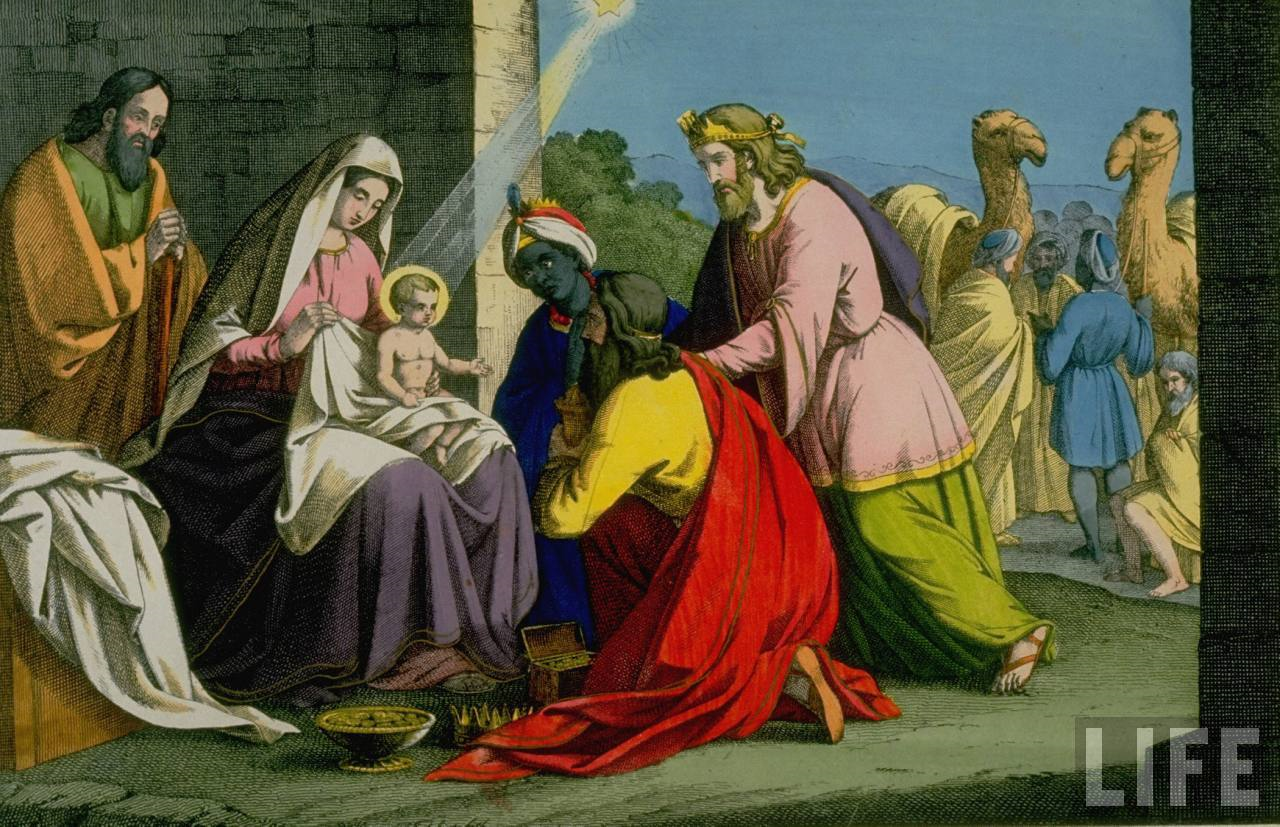
Picture 6. Wise Men Balthasar, Melchior and Caspar present gifts to Christ.
3.3 Gift Receipt.
When you buy something as a gift for your nearest and dearest, you may ask for a Gift Receipt. Very often during holiday time (Christmas, Easter), you will be offered such a Gift Receipt without asking for it. In case your relatives or friends don’t like the gift, they can go to the store with the Gift Receipt, and return it for money. As a rule, the price of the gift is not indicated on the Gift Receipt. On this receipt you can only find the name of the store and code or number of the purchased item.[14]
3.4 Rose Parade.
This colorful event takes place every year during Christmas time in the small town of Pasadena that is situated not far from Los Angeles, California (Pic.7). During Christmas time, Colorado Boulevard in Old Town Pasadena is a picture-perfect portrait of the season: shops are adorned with wreaths and thinking white lights, shoppers make their way past metal bleachers in place along the main route of the upcoming Rose Parade.
Since the first parade in 1890, the preparations that accompany the Tournament of Roses have been as much a part of December in Pasadena as any holiday tradition. A lot of years ago, small crowds of onlookers wearing straw hats bustled dresses lined dusty streets. Nowadays, there is still no better way to ring in the New Year than with the sweet smell of roses. With its floral floats, marching bands and equestrian units, the Rose Parade draws one million spectators, and it is broadcast live to millions more worldwide. Pasadena and neighboring cities offer an up-close look at the Rose Parade in the days leading up to the event. As a rule, before the Parade people can watch float teams applying natural materials, including seeds, dried flowers and more fresh rose blooms, to spectacular floats. Usually the are 4 float-decorating pavilions. The Rose Parade usually lasts for a week and includes;
1. Band fest where Rose Parade bands perform field shows:
2. Equates-it is a show of Rose Parade horses:
3. Rose Parade itself, which is a colorful show of magnificent floral floats, marching bands, high-stepping equestrians;
4. Post-Parade Showcase of floats in which more than 50 floats are on display.[14]
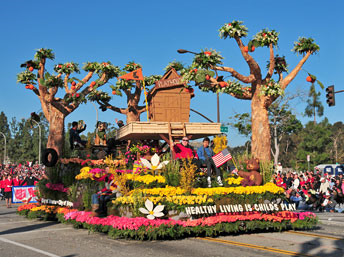
Picture 7. Rose Parade in Pasadena.
3.5 The Christmas Pantomime.
A pantomime is a traditional English entertainment at Christmas. It is meant for children, but adults enjoy it just as much(Pic.8). It is a very old form of entertainment, and can be traced back to 16th century Italian comedies. Harlequin is a character from these old comedies.
There have been a lot of changes over the years. Singing and dancing and all kinds of jokes have been added; but the stories which are told are still fairy tales, with a hero, a heroine, and a villain. Because they are fairy tales we don’t have to ask who wins in the end! The hero always wins the beautiful princess, the fairy queen it triumphant and the demon king is defeated.[8]
In every pantomime there are always three main characters. These are the “principal girl”, “principal boy”, “and the dame”. The principal boy is the hero and he is always played by a girl. The principal girl is the heroine, who always marries the principal boy in the end. The dame is a comic figure, usually the mother of the principal boy or girl, and is always played by a man.
Pantomimes are changing all the time. Every year, someone has a new idea to make them more exiting or more up-to-date. There are pantomimes on ice, with all the actors skating; pantomimes with a well-known pop singer as the principal boy or girl; or pantomimes with a famous comedian from the English theatre as the dame. But the old stories remain, side by side with the new ideas.[8]
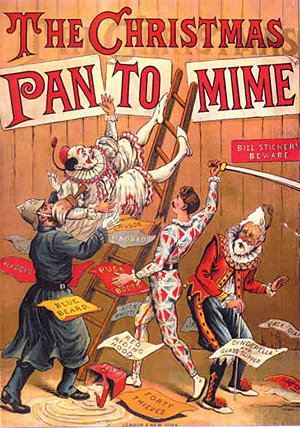
Picture 8.The old poster of Christmas Pantomime.
3.6 Yule Log.
The traditional English Christmas included the burning of a massive Yule log that had been ceremoniously dragged in by many hands and placed on the hearth on Christmas Eve.(Pic.9) The mundane reason for the custom was to keep chilly English houses warm, but there was a ritualistic aspect to it as well. “Yule” (in Anglo-Saxon, geol) was the winter solstice period in pagan England, and the burning of a huge log at this time was part of the ceremonies that honored the return of the sun. In a classic instance of sympathetic magic, the ancient Celtic and Teutonic peoples would light the log as both a register and an assurance of heavenly light. The cyclical nature of the custom was enshrined in the later folk belief that each year’s Yule log should be lighted from the relit remnant of the last year’s.
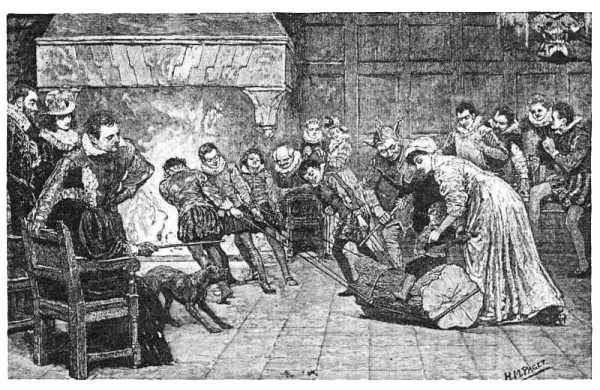
Picture 9.Burning of Yule Log.
Other folk beliefs attended the log ceremony. T.G. Crippen mentions, for example, the notion that girls with unwashed hands who touched the log would cause the fire to burn dully and the more common superstition that all who helped drag in the behemoth would be protected from witchcraft for a year. There was also the strange practice of drawing a chalk man on the log before it was put to the flame-a recollection, perhaps, of human sacrifice. [8]
3.7 Modern traditions of Christmas celebration.
Every country has its own tradition of celebrating Christmas. Some of the Christmas customs are or were the same in different countries of the world. Celebrations properly start on 24 December (January, 6), Christmas Eve, there have been several weeks of preparations beforehand. In Great Britain this time of conscious anticipation is called Advent. In many homes and churches a Advent wreath is Hung, made of Fir and adorned with four candles. One candle is lit on the first Advent Sunday, two on the next, and so forth until all four burn for Christmas Eve. This is a time of decorating, baking, and exchanging cards. It is also a time for seasonal music and plays based on the Biblical account of the nativity. Christmas day is the biggest day of the holiday. On Christmas morning (often very early!), children open the presents that were in their sacks. So many families go to church. It became a tradition to celebrate Christmas Day with plently of eating and drinking.
December 26, this is called Boxing Day, is also a holiday. On Boxing Day most people go out to see friends, watch sports events, go to the theatre to see a pantomime, or increasingly nowadays, go shopping most of the large stores start their winter sales on Boxing Day. But the Christmas holiday is still not over. In fact, many offices and factories close for the whole Christmas period from 24 December to January 2. On New Year’s Eve there are a lot of parties and at midnight everyone joins hands to sing Auld Lang Syne. Then after New Year’s Day to sleep it off. That’s Christmas over for another year .[10].
We should mention that the most popular Christmas customs and traditions are Nativity, Rose Parade, Christmas Pantomime, Gift Receipt. Christmas is often criticized for Gift Receipt. Thanks to it Christmas has become “the most commercialized festal of the year” People take it in different ways. In “Vane Sisters”[11] this tradition is characterized as “a weak solution of mixed auras or simply the routine shift of a humdrum guardian”. It means that some people assume its musical nature. We also suppose, this tradition was closely connected with the main aim of sending Jesus Christ to the earth- to help people.
3.7.1 Youth traditions of celebration Christmas.
Christmas - one of the most important religious holidays, traditions, celebrations of which go back to centuries. But many of our contemporaries, as well as young people growing up in atheistic times have a vague idea about the traditions associated with this holiday, or do not know any of them. [13]. Our research showed that in cultural families, each family member knows traditions of celebrating Christmas. In Christian families, ignorance of the traditions of Christmas is considered indecent. People are looking forward for Christmas, prepare for it long and carefully. Everyone from young to old spent lavishly on gifts to relatives and friends.
CONCLUSION
As a result of a research undertaken by the author made the following conclusions:
Responding to the first task was concluded: Christmas takes its name from an old English word Christes, or Christ. Dutch has a similar word, Kerstmis, often shortened to Kerst. The German name Weinachten means simply “hallowed night”. After the conversion of Anglo-Saxon Britain in the early 7th century, Christmas was referred to as geol. Many people find Christmas time to celebrate the birth of Christ. In fact, no one started serious discussion on the settlement date of the birth of Christ, no one knows the exact date and year of birth of Christ. The church adopted December 25 as the day of the visit of Mary angel Gabriel. Adding nine months to this date, obtained on December 25. So, the choice of dates for the celebration of Christmas was quite controversial.
Answering the second task was made the following conclusion: the main symbol of Christmas is the Christmas tree tradition in the decoration of which began to Martin Luther. Prince Albert introduced the Christmas tree at the Christmas celebration of the royal family. The main role of trees - to create an atmosphere of happiness. One of the folk heroes - Santa Claus, who carried the gifts to children. In different countries it is called differently. The current image of Santa Claus was created by German-American cartoonist Thomas infusion. Rudolph, Reindeer, is considered the second most popular folk hero, also known as Christmas Rudolph, whose glowing nose lit the way to Santa Claus in the story "a foggy Christmas Eve." Stories about Rudolph were established advertising agent, Robert Montgomery Ward Mayem.
Responding to the third task, was made the following conclusion: the most famous
tradition of celebrating Christmas is a Christmas miscellany, The Nativity, Gift Receipt, Rose Parade, The Christmas Pantomime and the Yule Log. The celebrations usually nachanayutsya December 24, Christmas Eve, before attending a few weeks to prepare.In the UK, this time conscious expectations called Advent. It's time for decorating, baking, exchange cards, as well as seasonal music and plays on the biblical basis.Christmas is the main day of celebration. On Christmas morning, very early, children open gifts. Many families go to church. Become a tradition to celebrate Christmas with plenty of food and drink.
On the basis of the study was made following general conclusions: despite the popularity of various Christmas customs and traditions, but few young people think about the origin of the holiday and its traditions. The holiday itself has lost its religious significance for young people. Thanks to its many traditions that come from ancient times, this is certainly the most colorful festival of the year. Many young people celebrate it as much as the early Christians many years ago. Christmas customs and traditions are immortal. Study of the origin of Christmas makes us think about the relationship between different generations and the significance of the past for us, people who live in the 21 st century.
The hypothesis was confirmed in part, unnecessarily despite the popularity of Christmas customs and traditions, few people think about the origin of the holiday and its traditsiyah.Nashe study showed that most families in the cultural Christmas celebrations are really celebrating the birth of Christ. For the greater part of the population, this holiday is a good opportunity to give each other gifts, and lots of delicious food and drink and have fun.
LIST OF SOURCES:
1. The All Nations English Dictionary, p.103,903
2. The Catholic Encyclopedia, 1913
3. The Oxford Dictionary of Christian church, Oxford University
4 The Encyclopedia for children, 2001, p.993
5. English for children №21, 1994, p. 4-5
6. English №20, 2000, p.18- 19
7. L.P. Ternaeva,Culture and communication, p. 48- 49
8. English №46/1996, p.12-13
9 English №47/1996, p.1
10. From Legend, Lies and Cherished Myths of American History by Richard Shenkman English №47/ 1996 p.13
11. English № 46/1996 p.13
Internet sources:
Administration of the site school-collection.Christmas traditions in different countries.
13.http://gifter.biz/rozhdestvenskie-tradicii-v-raznyx-stranax/ Administration of the site Gifter. Christmas traditions in different countries.

Нравится материал? Поддержи автора!
Ещё документы из категории английский язык:
Чтобы скачать документ, порекомендуйте, пожалуйста, его своим друзьям в любой соц. сети.
После чего кнопка «СКАЧАТЬ» станет доступной!
Кнопочки находятся чуть ниже. Спасибо!
Кнопки:
Скачать документ